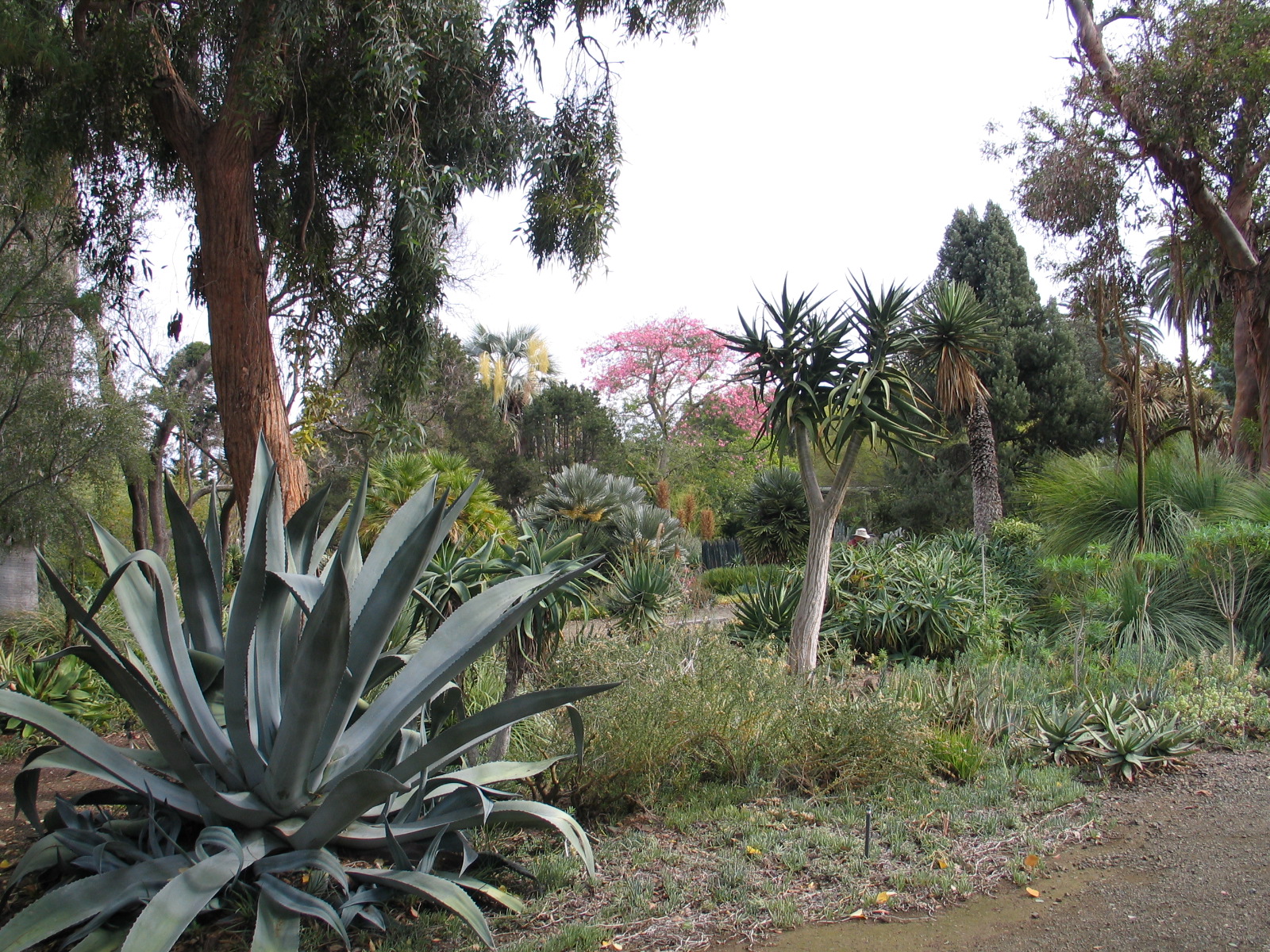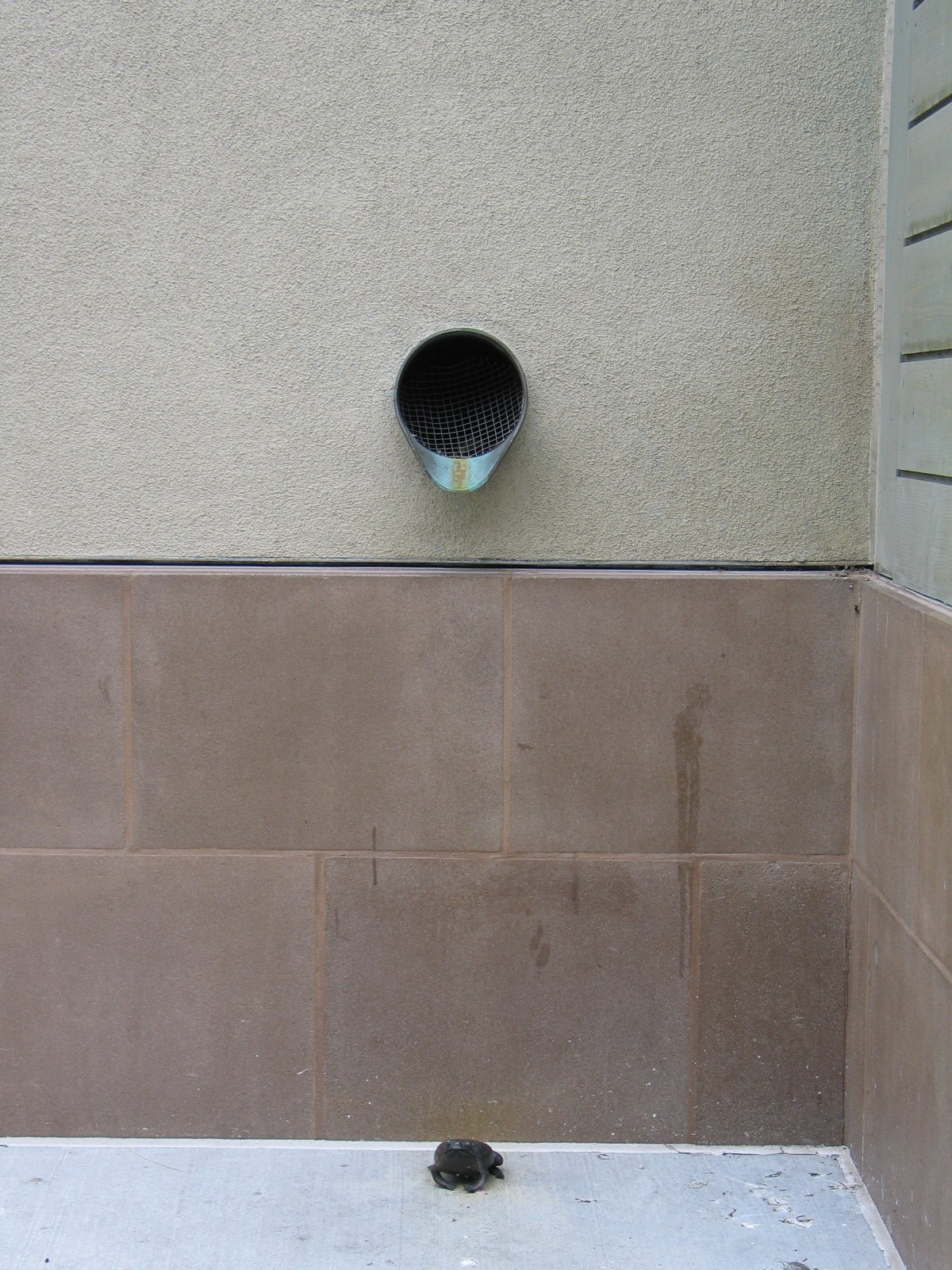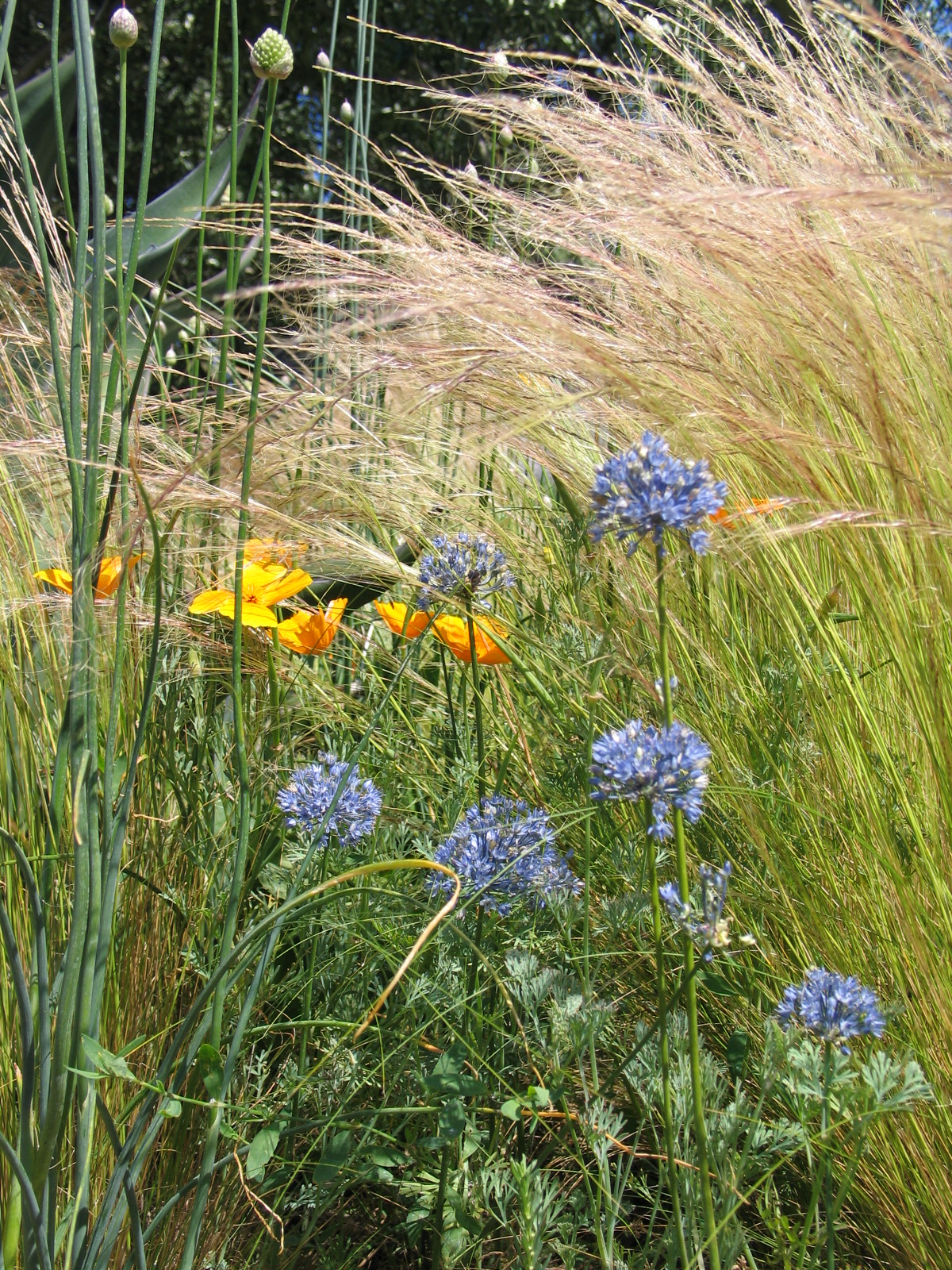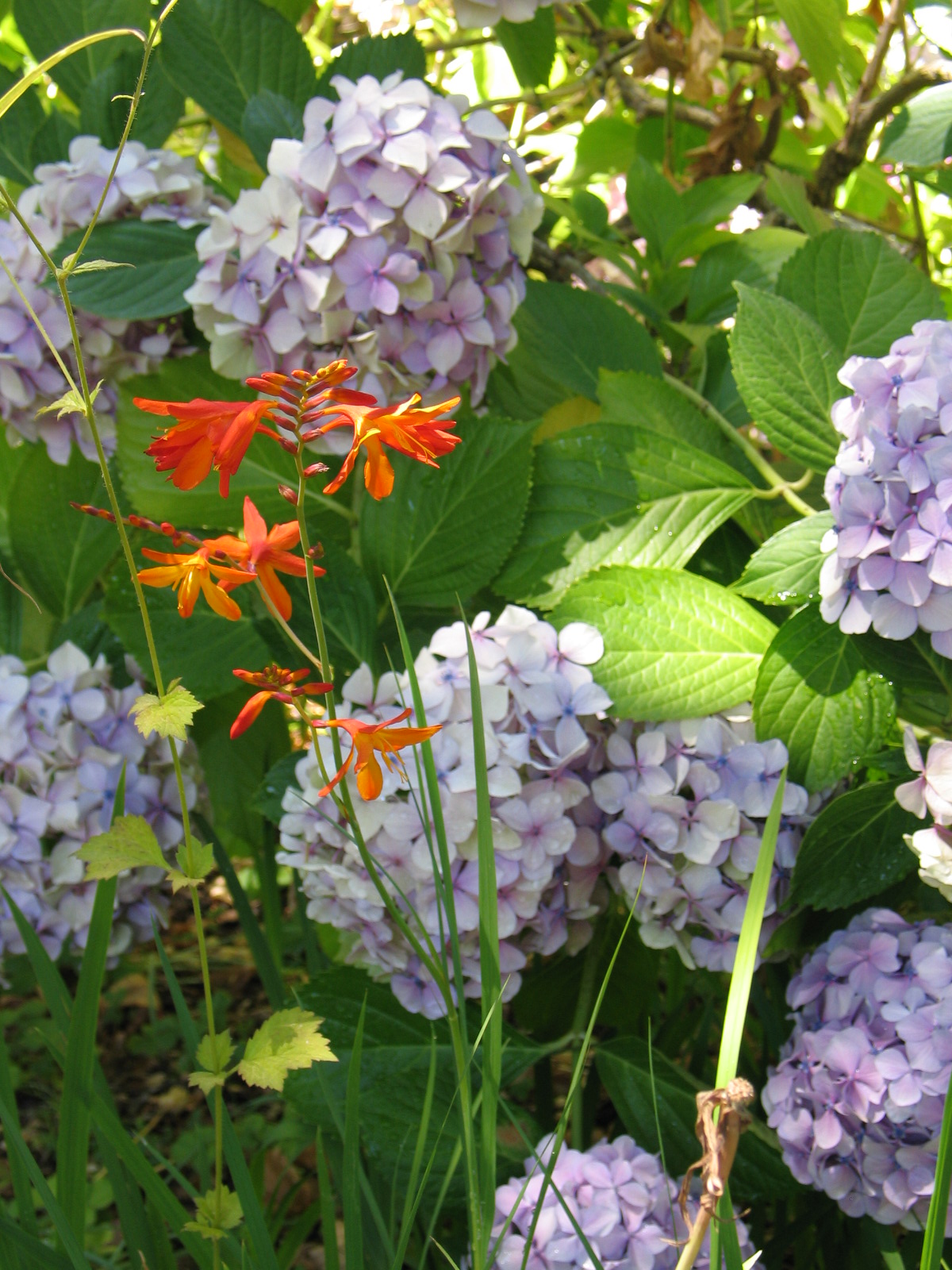 I wonder sometimes about the planting design process of other designers. Some always design the "bones" of the garden first and work their way down to smaller plants, others begin with a point of inspiration, a style, and build a garden around that concept. I seem to work in more than one direction at a time. Occasionally a garden will tell me what it wants to be, sometimes I have to ponder longer to find its voice.Whatever happens on a project, though, I maintain a substantial image library. I recently visited Filoli earlier this month and took the photo above of Crocosmia and Hydrangeas planted together. I recognize that not everybody would respond favorably to this combination based solely on the colors, but seeing them together like that gave me the idea for this post - what if you compared several cultivars of Hydrangea with a variety Crocosmias (in a mix-and-match format)? What interesting planting combinations would arise? Would others find Crocosmia combined with Hydrangea attractive then?Just a thought. I like them all.
I wonder sometimes about the planting design process of other designers. Some always design the "bones" of the garden first and work their way down to smaller plants, others begin with a point of inspiration, a style, and build a garden around that concept. I seem to work in more than one direction at a time. Occasionally a garden will tell me what it wants to be, sometimes I have to ponder longer to find its voice.Whatever happens on a project, though, I maintain a substantial image library. I recently visited Filoli earlier this month and took the photo above of Crocosmia and Hydrangeas planted together. I recognize that not everybody would respond favorably to this combination based solely on the colors, but seeing them together like that gave me the idea for this post - what if you compared several cultivars of Hydrangea with a variety Crocosmias (in a mix-and-match format)? What interesting planting combinations would arise? Would others find Crocosmia combined with Hydrangea attractive then?Just a thought. I like them all.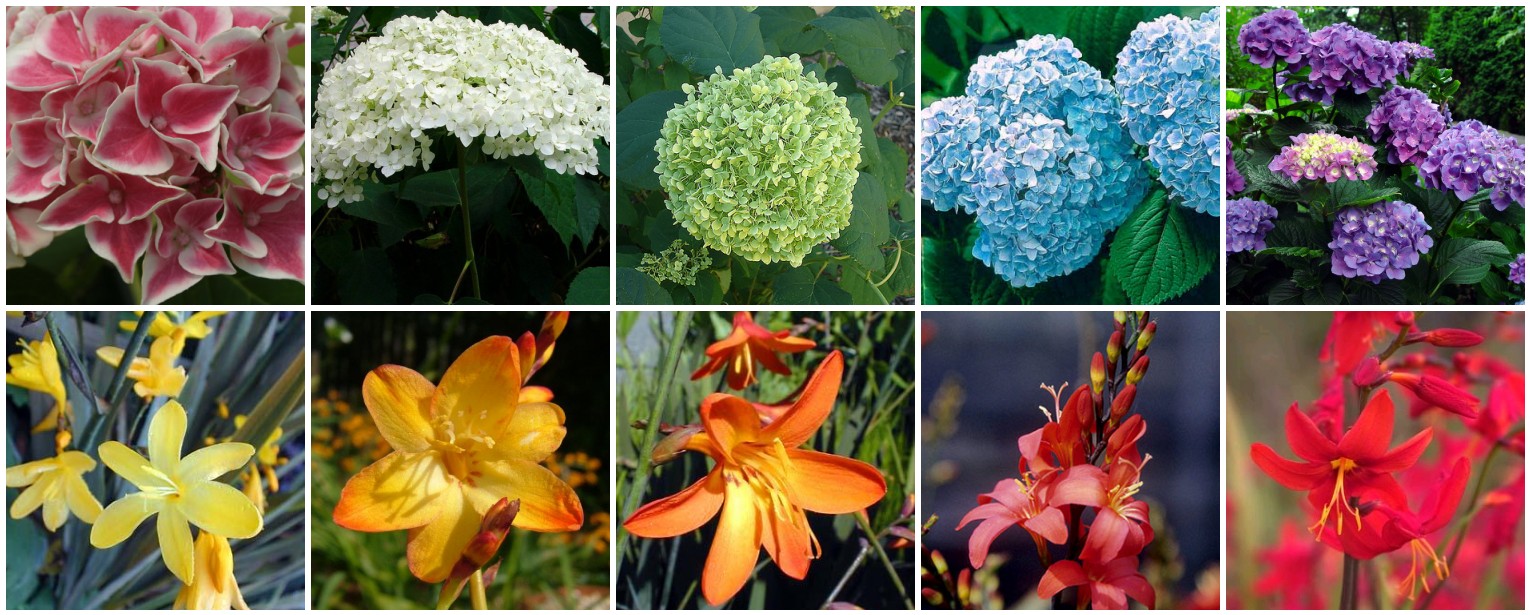
Filoli in August
 I try not to assert design "rules" because for every rule, there is likely at least one successful example that breaks it...but I do believe that Filoli is a fantastic place to see occasions when an area in its 'off-season' is beautiful, too.
I try not to assert design "rules" because for every rule, there is likely at least one successful example that breaks it...but I do believe that Filoli is a fantastic place to see occasions when an area in its 'off-season' is beautiful, too. What you are focused on is what you will notice. If you are focused on how much you hate a certain view, guess what? That view will bother you all the time. If you are looking for bare patches of soil, congratulations! Bare soil is what you will find. What would happen if we all adjusted our attention? What if we saw more than bare soil and ugly views?
What you are focused on is what you will notice. If you are focused on how much you hate a certain view, guess what? That view will bother you all the time. If you are looking for bare patches of soil, congratulations! Bare soil is what you will find. What would happen if we all adjusted our attention? What if we saw more than bare soil and ugly views? The paired images here are from Feb 2010 and August 2010.
The paired images here are from Feb 2010 and August 2010.
Filoli Before Spring
Notice how even in lousy light and with the deciduous woody plants being void of leaves, this garden is photogenic? That it's simple (especially at this time of year, before the flower riot is in full swing) the plantings are stunning, and how the structure of this garden - the layers and mass of its "bones" - support the flower beds. When looking at the images, did you feel like it was not colorful enough? I didn't.
Read moreFirst Contact and The Lingo
"Could I request a post on finding and making first contact with a designer for those of us with gardens out of your jurisdiction so to speak? You’ve convinced me that outside help would be a good idea for my yard, but I don’t know where to go for it, and I don’t want to give the wrong first impression by not knowing the right terms."
Read moreFavorite Projects
About 5 years into my career, I left a job working on a wide variety of projects (hospitals, schools, trail systems, public parks, commercial spaces, but very few private residences) for a job that was exclusively private residences and estate work. I thought at the time that I was "looking for the soul" in Landscape Architecture....
Read moreHow to become a Great Client
I just got this blog post in my e-mail from Seth Godin this morning which ties in nicely with the book What Your Contractor Can't Tell You that my good friend Susan introduced me to. Nevermind that Mr. Godin uses logo design as his example, and never mind that the book focuses on working with Architects and contractors as opposed to Landscape Architects. BOTH sources discuss the same notion: being a "good" client, or at the very least, an informed one (weirdly, though, they seem to disagree on some points)."Good" clients are beneficial to the entire process, save everyone time, money, and headaches. The responsibility is not the client's alone, however. When the relationship between the client and the professionals they've hired is a productive one, the project always benefits. I am thinking about getting extra copies of that book for my office (knowing full well that suggesting to someone that they read either the post or the book won't necessarily result in them reading either). It is that good. No, really. The $15. you spend on that book can save you thousands in the long and short run. Not a bad return on investment!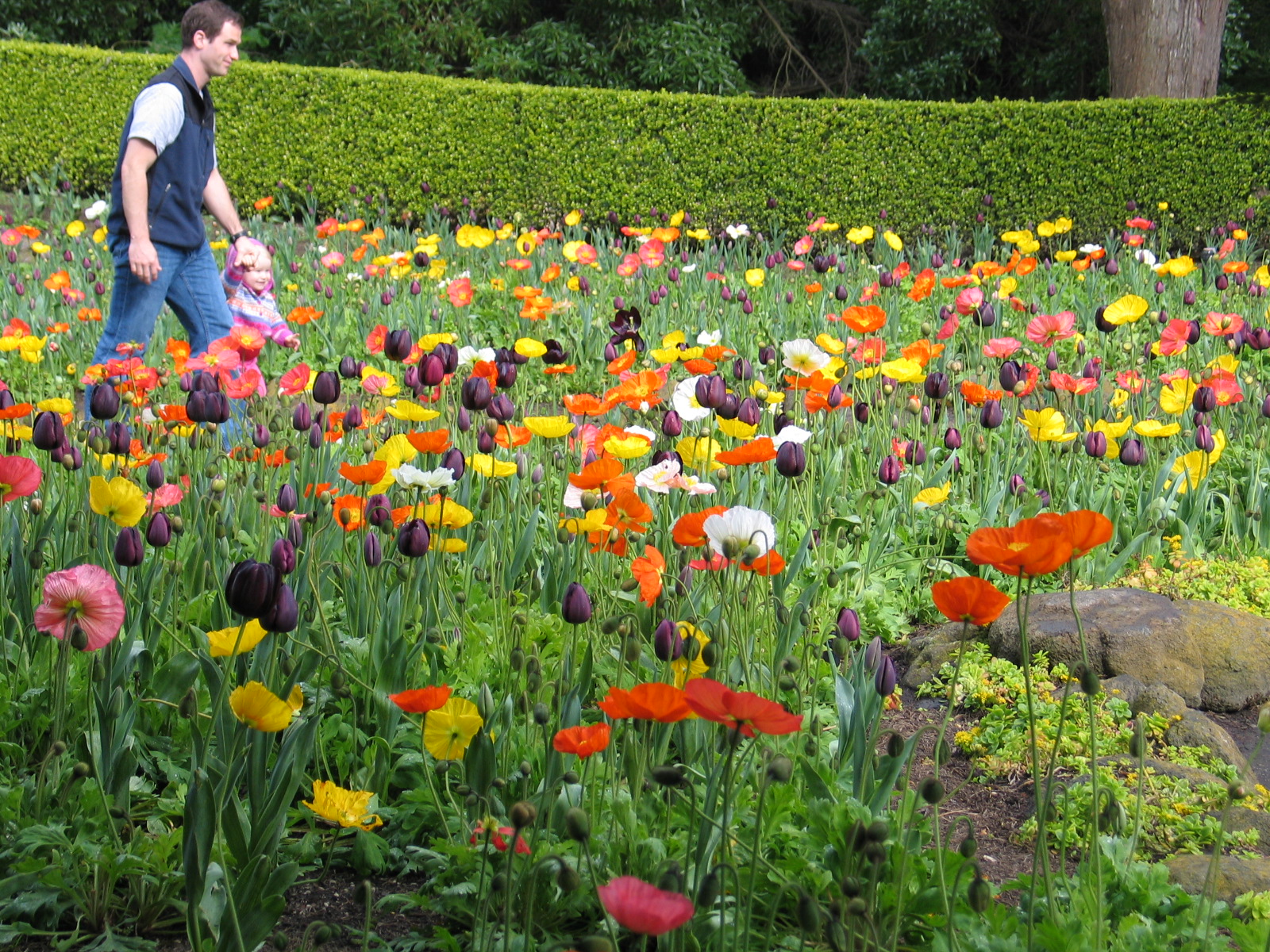 I leave you with images from the Windmill Garden in San Francisco - a seasonal planting that I really enjoyed back in April 2006.
I leave you with images from the Windmill Garden in San Francisco - a seasonal planting that I really enjoyed back in April 2006.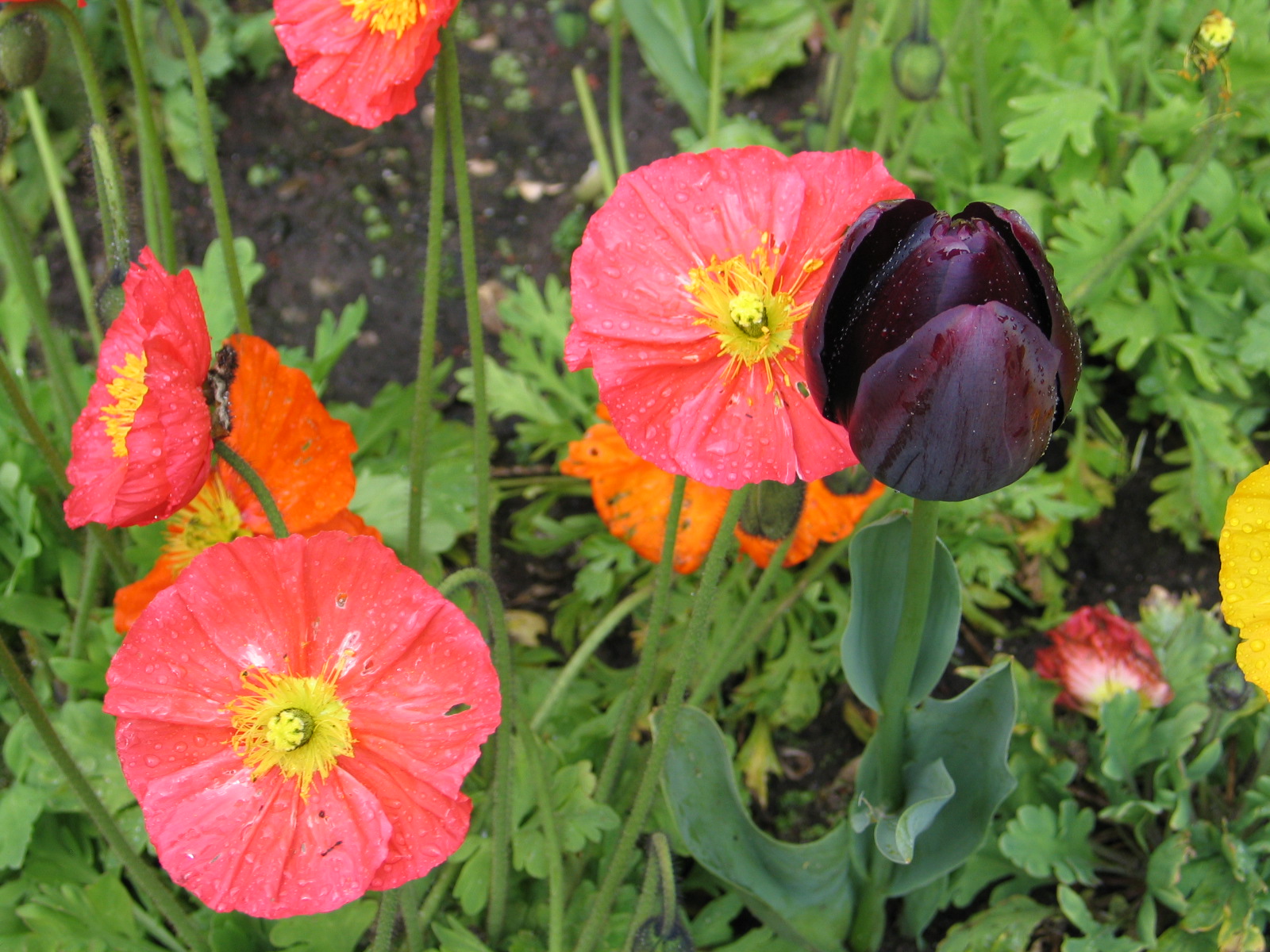
Water use's not-so-obvious issues
I am sorry to say that despite the incredible amount of coverage that water use gets these days, almost none discusses some of the long-term effects of inappropriate watering practices. I am not going to start counting how many gallons you can save by switching to drip irrigation, or the fact that spray irrigation can lose 50% to the wind and evaporation before your plants get any of it....nope, I'm not. I do want to mention a few things that I've learned through being a Landscape Architect and a gardening enthusiast:Roots: I read a letter to the editor in our glorious Alameda Journal (23 october 2009) in which a woman complains about street tree roots buckling her walkway. I have not seen her property, but I would bet a whole lot of donuts that the problem can be traced back to shallow irrigation. Roots know what they're doing, they take up water and nutrients for the plant (tree, shrub, whatever). They will go where the water is, and if the good stuff is to be found in the top layer of the soil, that is where you will find the roots. This goes for a tree, a shrub, all plants including a lawn. So when your sprinkler system is on for 10 minutes and soaks in maybe 3", or you stand outside with a hose for half an hour, you can expect the majority of roots to gravitate to that topmost layer, including those of walkway-bucking trees.Here's the part I wish those water-wise articles would mention: IF you water your plants deeply and less frequently, their root systems learn to dive deep to find it. Even a lawn can have roots that are a couple of feet deep! Water deeply, and the water lasts longer, is available to the roots of your plants, and then when there is a drought, those plants have a better survival rate thanks to their deep, probing root structure!!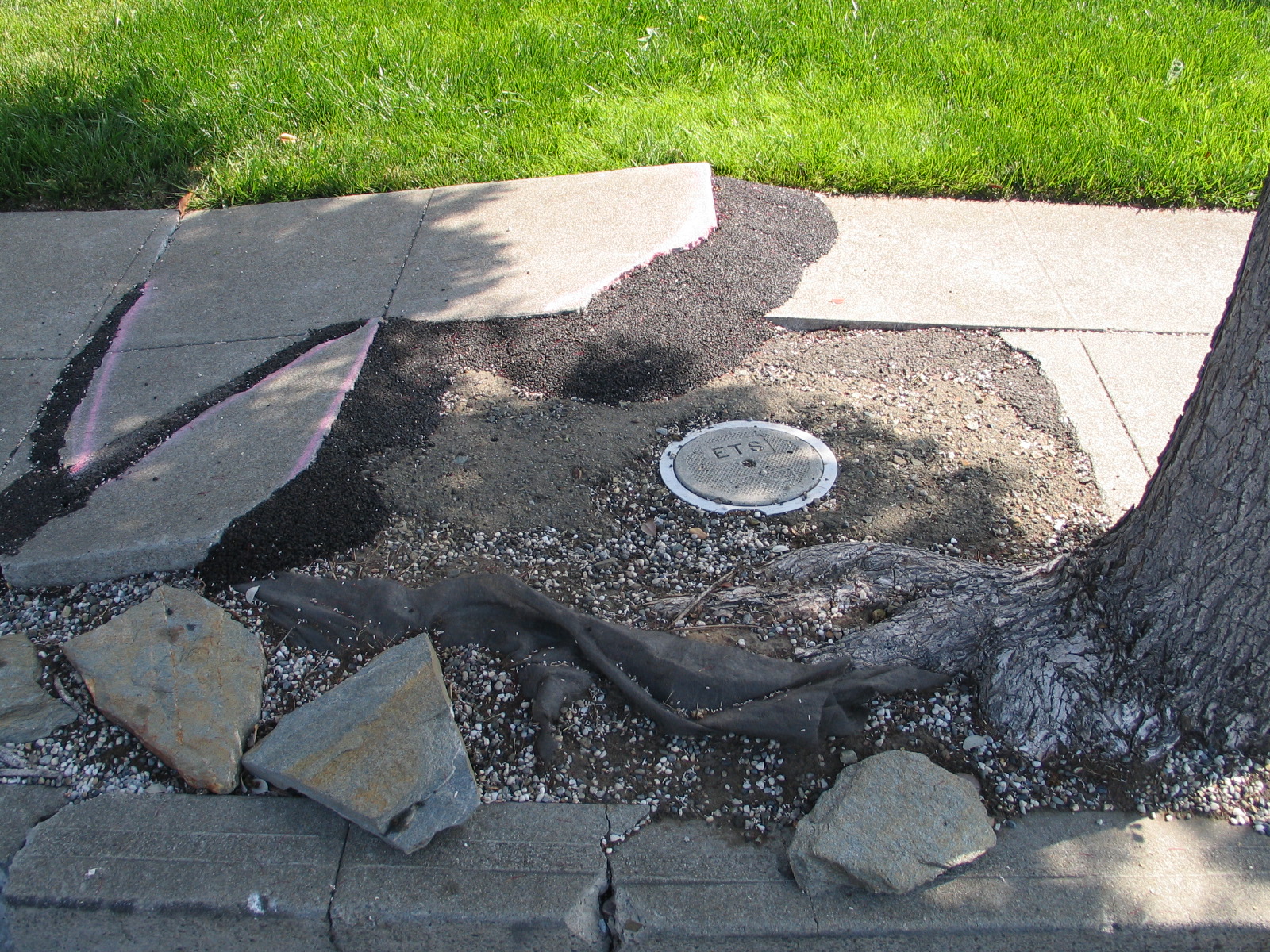 Containers: I prefer terracotta pots for the numerous ways in which they have been a good home to my plants over time (oh yeah, this is about water, not pots... I'm getting back on track now). Whatever containers you use, when the root ball dries out, it shrinks and pulls away from the sides. The next time water is poured into that container, the water runs around the rootball (not through) and out the bottom, doing the roots of your plants no good. There are goofy weird products on the market that claim to hold moisture in the soil, or add water over time, blah blah. I've tried many and never liked one. In my garden, I have a 1/8" thick wire stake of forgotten origin that I use to poke holes into the rootballs of neglected container plants when I water. The holes allow air to escape, water to penetrate, and roots to get what they need. If I have been particularly rotten to my container plants, I fill a bucket or my wheelbarrow with water and I soak them in it to allow them to really soak it up. A note: I don't think self-watering containers work well. The photo below shows a lovely display from the Los Angeles Getty Museum gardens several years ago - I wonder, though, are they hand-watered? is the water allowed to drain out? Was I just lucky enough to see this display before that water stained the paving? Container plants need water and drainage in order to stay nice for more than a short time.
Containers: I prefer terracotta pots for the numerous ways in which they have been a good home to my plants over time (oh yeah, this is about water, not pots... I'm getting back on track now). Whatever containers you use, when the root ball dries out, it shrinks and pulls away from the sides. The next time water is poured into that container, the water runs around the rootball (not through) and out the bottom, doing the roots of your plants no good. There are goofy weird products on the market that claim to hold moisture in the soil, or add water over time, blah blah. I've tried many and never liked one. In my garden, I have a 1/8" thick wire stake of forgotten origin that I use to poke holes into the rootballs of neglected container plants when I water. The holes allow air to escape, water to penetrate, and roots to get what they need. If I have been particularly rotten to my container plants, I fill a bucket or my wheelbarrow with water and I soak them in it to allow them to really soak it up. A note: I don't think self-watering containers work well. The photo below shows a lovely display from the Los Angeles Getty Museum gardens several years ago - I wonder, though, are they hand-watered? is the water allowed to drain out? Was I just lucky enough to see this display before that water stained the paving? Container plants need water and drainage in order to stay nice for more than a short time.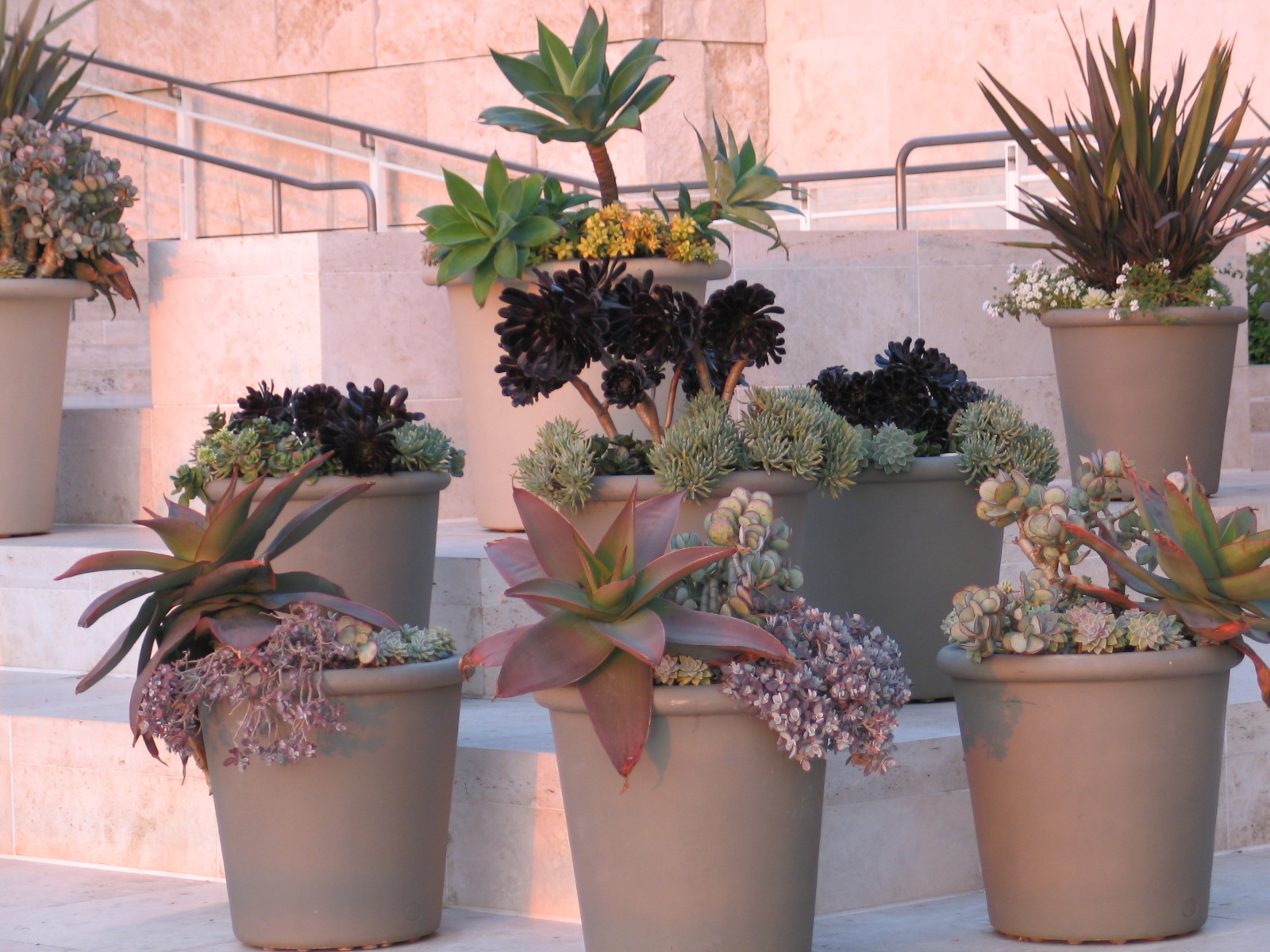 Watering Practices: I love walking around in the evening, winding down after my day. I see a lot of irrigation at night, though, and wish that more people understood the benefits of watering in the early am instead. Plants lose most of their moisture during the heat of the day as a byproduct of photosynthesis (evapotranspiration from photosynthesis is where plant-released oxygen comes from), so watering before plants need it is ideal (but if you have wilting, dry plants at noon, they need it asap!). If you have good drainage, so much the better because the (assuming we're not growing aquatic plants) roots won't be left to wallow in suffocating muck. Leaving plant roots in cool, damp soil as the temperature drops (evening watering) can promote the growth of undesirable mold, fungus, and plant disease. Please also pay attention to the drainage of your soils! The water here is pooling due to being both trapped by the edging and also because the soil in this area is so over watered, it has developed a scummy skin that keeps their irrigation efforts on the surface for hours after each watering.Please know that there are evapotranspiration (ET) irrigation systems that can adjust automatically (with the help of a weather station) to turn the water off when it is raining, adjust for seasons, soils, slopes, and planting types! You do NOT have to rely on remembering to run out in the rain to turn the thing off or waiting for your maintenance service to do it for you.
Watering Practices: I love walking around in the evening, winding down after my day. I see a lot of irrigation at night, though, and wish that more people understood the benefits of watering in the early am instead. Plants lose most of their moisture during the heat of the day as a byproduct of photosynthesis (evapotranspiration from photosynthesis is where plant-released oxygen comes from), so watering before plants need it is ideal (but if you have wilting, dry plants at noon, they need it asap!). If you have good drainage, so much the better because the (assuming we're not growing aquatic plants) roots won't be left to wallow in suffocating muck. Leaving plant roots in cool, damp soil as the temperature drops (evening watering) can promote the growth of undesirable mold, fungus, and plant disease. Please also pay attention to the drainage of your soils! The water here is pooling due to being both trapped by the edging and also because the soil in this area is so over watered, it has developed a scummy skin that keeps their irrigation efforts on the surface for hours after each watering.Please know that there are evapotranspiration (ET) irrigation systems that can adjust automatically (with the help of a weather station) to turn the water off when it is raining, adjust for seasons, soils, slopes, and planting types! You do NOT have to rely on remembering to run out in the rain to turn the thing off or waiting for your maintenance service to do it for you.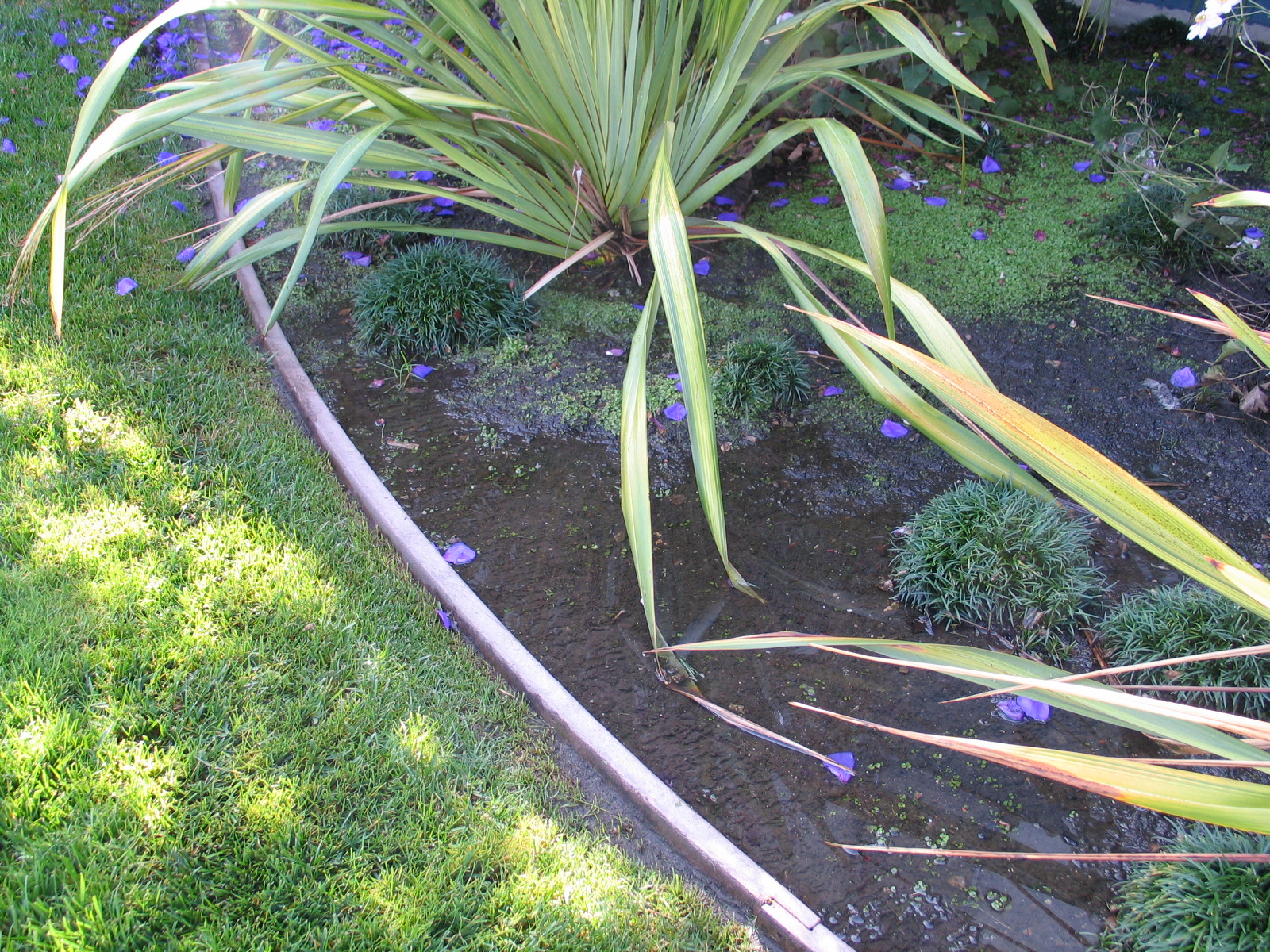 Runoff: Okay, so we've talked about water and your vegetation, and we know that we don't want to water the sidewalk, but what about all that flooding that we get in a good storm? Permeable paving products hope to help solve the problem, see this report adopted by the California Coastal Commission in March, 2007. I would point out, however, that permeable paving solutions are dependent on proper maintenance, and that even compacted soil can resist water penetration as well as any hard paving material. So, not to get into a discussion of style or design, I would encourage everyone to consider where a permeable solution can be used. It is far nicer to have all that lovely rainwater seep into the soil than to run off our urban and suburban surfaces, filling up the storm drains instead. I was given this book on Rain Gardens as a gift about a year ago, it is worth reading. I bring up runoff, because I've noticed several water-saving lists recommending adding non-planted areas to cut down on the amount of water needed to irrigate. I think that suggesting this is misleading and not necessarily an environmentally friendly practice.
Runoff: Okay, so we've talked about water and your vegetation, and we know that we don't want to water the sidewalk, but what about all that flooding that we get in a good storm? Permeable paving products hope to help solve the problem, see this report adopted by the California Coastal Commission in March, 2007. I would point out, however, that permeable paving solutions are dependent on proper maintenance, and that even compacted soil can resist water penetration as well as any hard paving material. So, not to get into a discussion of style or design, I would encourage everyone to consider where a permeable solution can be used. It is far nicer to have all that lovely rainwater seep into the soil than to run off our urban and suburban surfaces, filling up the storm drains instead. I was given this book on Rain Gardens as a gift about a year ago, it is worth reading. I bring up runoff, because I've noticed several water-saving lists recommending adding non-planted areas to cut down on the amount of water needed to irrigate. I think that suggesting this is misleading and not necessarily an environmentally friendly practice.
Sentimental Plants
 My mom used to have "naked ladies" (Amaryllis beladonna) in her garden until she dug them all up and gave them to a neighbor. Lucky for me, she had some Nerine bowdenii shoved in a corner of the yard (not planted, just set aside bare) and when I asked if the Amaryllis were all gone, she stuffed the Nerine in a box and gave them to me. Hey, close enough. Every fall when these things bloom, I think of "home" (though I haven't lived there in quite a long time).I've had a few clients with similar hand-me-down plants, and I think these are (depending on the client's wishes, of course) essential to any new design work. How rude would it be if you had a Hydrangea from a loved one's garden (heaven forbid that person is gone!) and I just designed it right out (and oh, yes, I've seen this happen) of the new garden.So below are my Nerine. I'll come clean with you: my yard is a disaster area (no, check that - it is a teensy American Meadow), I haven't done any maintenance since spring, staying inside and working on everything else instead. I live in an apartment, so yes, my friends, the Nerine are living in a kitty litter bucket with holes drilled in the bottom. They don't seem to mind, I pay them absolutely no attention whatsoever and look what they gave me back this year:
My mom used to have "naked ladies" (Amaryllis beladonna) in her garden until she dug them all up and gave them to a neighbor. Lucky for me, she had some Nerine bowdenii shoved in a corner of the yard (not planted, just set aside bare) and when I asked if the Amaryllis were all gone, she stuffed the Nerine in a box and gave them to me. Hey, close enough. Every fall when these things bloom, I think of "home" (though I haven't lived there in quite a long time).I've had a few clients with similar hand-me-down plants, and I think these are (depending on the client's wishes, of course) essential to any new design work. How rude would it be if you had a Hydrangea from a loved one's garden (heaven forbid that person is gone!) and I just designed it right out (and oh, yes, I've seen this happen) of the new garden.So below are my Nerine. I'll come clean with you: my yard is a disaster area (no, check that - it is a teensy American Meadow), I haven't done any maintenance since spring, staying inside and working on everything else instead. I live in an apartment, so yes, my friends, the Nerine are living in a kitty litter bucket with holes drilled in the bottom. They don't seem to mind, I pay them absolutely no attention whatsoever and look what they gave me back this year: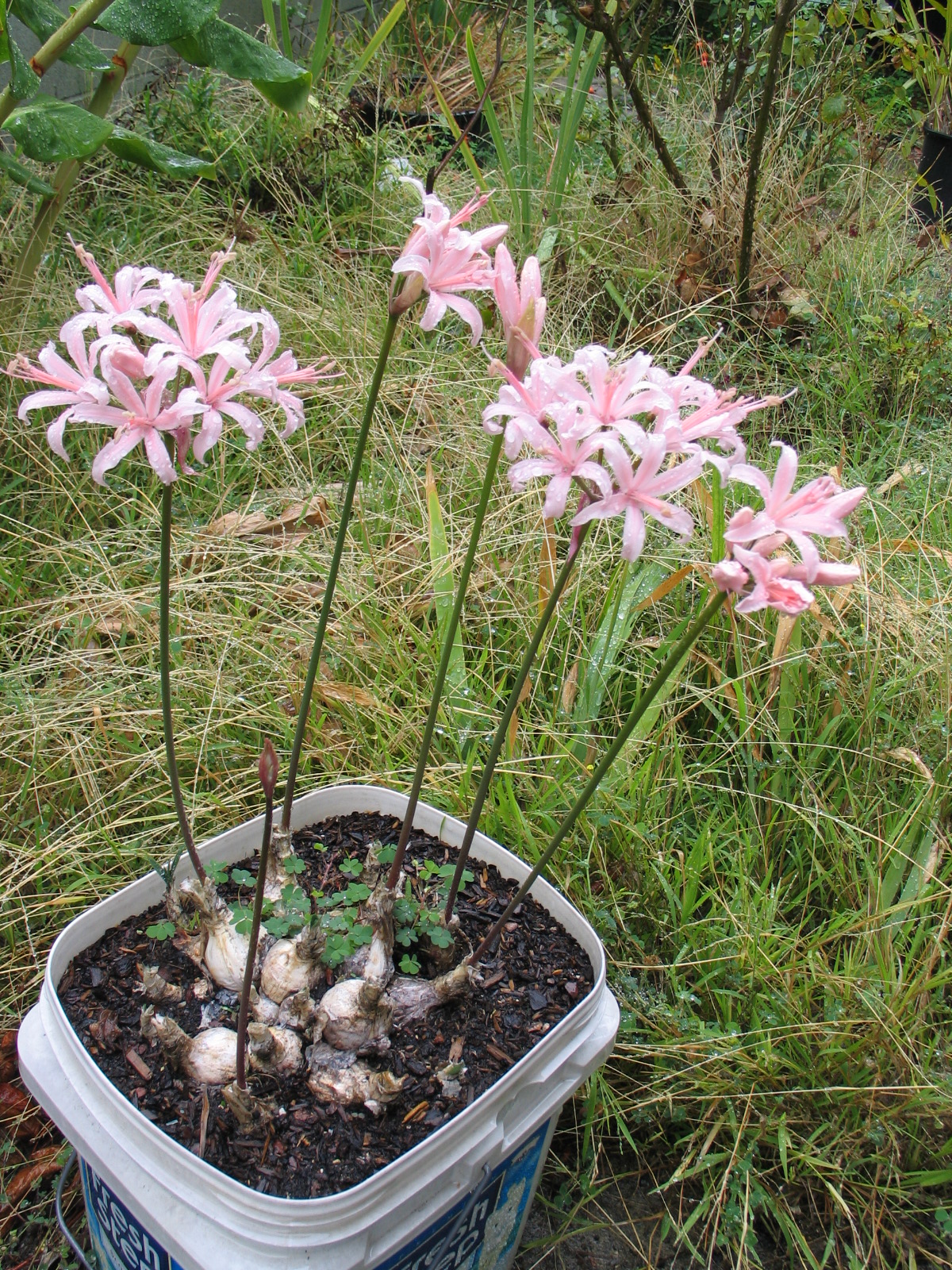
Ridiculous quantities of inspiration
GAP Photos is a UK based website that has an insane quantity of garden photos. They've got the most amazing search abilities, and their photos list actual plant names whenever possible. Being of the UK, most of the images are "english garden" types, but there's also images of flower shows (like Chelsea) and beautiful veggies. I think the site speaks for itself, just watch the clock - a person could get lost in there for hours.
Water conservation in the landscape - the obvious stuff.
If you have read anything online, or watched the news, or read a paper in the last decade, you already know that water use and conservation is an issue in our state. Things that can save water include:* mulching* grouping plants into water-use zones, and using drought tolerant plants that are adapted to your area* switching from a typical sprinkler system to drip irrigation or sub-grade irrigation* Watering in the early am (not late at night, please!!! that actually promotes pathogens) so the plants can take up the water in time for the warm day ahead.* cleaning sidewalks and driveways with a broom instead of a hose (well, duh)
Read moreRuth Bancroft Garden
Ruth Bancroft Garden shade structure and Palo Verde tree
flowering blue palm
Ruth Bancroft Garden Oct 09
Bench at Ruth Bancroft Garden
I finally went. I've been meaning to go to the Ruth Bancroft Garden for years, and I am so glad I finally went today. Nice and overcast, not hot out, quiet with few visitors. They're closing soon for most of the winter, so this was a last chance day. I enjoyed the garden, but I was surprised both at how big it is and also how small given the reputation. Getting there is easy, figuring out what to do next was confusing. I passed the whole thing the first time, having missed the entrance....then we drove around the back to park in (apparently) someone's driveway?Anyway - the whole experience was fun, the garden could do with some work, more seating, and a proper gift shop. Today was one of those instances when I badly wish I could win the lottery and make it all better. Even though it is scrappy in many areas, it was also easy to find a flattering angle for pictures - something I attribute to the layout being very relaxed and organic, no edging or excessive ornament, and the plants being a well layered mix of nice big mature specimens with smaller plants. There were lots of plant labels but no labels on plants I wanted to identify / verify.All in all, worth the ten bucks to support a local treasure.....even if it did mix all kinds of weird stuff in with natives with little explanation of what we were looking at and there was only one bench in the whole place. I'd not call it a botanical garden, but I had a really nice half day out.
Mixed lawns - alternatives to turfgrass
Lawn daisies
Even if you don't go to the expense and trouble of removing an existing lawn regardless of its condition, simply overseeding with white clover can start a remarkable transformation. Adding clover to your turfgrass lawn can begins the transformation of adding little flowers, benefits from nitrogen fixing, and gaining a more textured, greener appearance.
Read moreOW, mommy, HOT!
scupper frog sculpture
A little girl walked up to this deer (one of two in the shopping center, both are kid magnets) and reached out to pet the deer. She said, "OW, mommy, HOT!" Aesthetics aside, as a designer, I will forevermore think twice before putting a metal kid-magnet in any position where it could get hot and potentially hurt someone.
Read moreGarden of Contrasts
garden of contrasts
However, when I was last at Cornerstone, I saw the Garden of Contrasts by Oehme and van Sweden for the first time. WELL! Spikey, beautiful green Agaves sit solidly among ever-swishing Stipa tenuissima and the flower heads of Allium caeruleum and the occasional California Poppy. The scene doesn't stop moving, revealing those little teensy hits of pure blue (the Allium flowers) and orange.
Read moreWhy Client Questionnaires Suck
Photo by Aarón Blanco Tejedor on Unsplash
I have decided that I dislike client questionnaires very much. For the purpose of designing a landscape of any sort, they fall far short of useful. I am sure someone somewhere found a client who enjoyed filling out forms, but I have yet to meet any prospective landscape project or client who responded well to (or was well-served by) a written questionnaire.
Read more10 things to do/consider - client homework
Aristea spiralis 4
You took the first step and decided to call someone, I'm glad you found me. Do yourself a favor and start thinking about your project - I will bring my own ideas, what I need to hear are yours. Here's some things to consider and be prepared to chat about when we meet:
Read moreObsess much?
mosaic green irises
Two of my favorite things below: silver/gray foliage and green flowering bearded irises. See, I told you it was esoteric.
Read moreLawns: what they're good for or not...
twin houses 1
When asked about turf grass lawns, some clients feel that they should have one but cannot provide a particular reason. "Because they're nice" someone once said to me. I don't think that is reason enough if there's no functional or aesthetic need for it. If a lawn fills a particular emotional need or is meaningful in some way, that is a different story. Unfortunately, the care required to keep them healthy makes turf grass lawns one of the least environmentally friendly growing things you can have.
Read moreWho does what!?
Photo by Andy Beales on Unsplash
Pay close attention to the wording under Landscape Contractor, Nurserypersons, and Unlicensed Persons as opposed to the wording for Landscape Architect.
Read moreColors from nature
palette generator bighugelabs.com
I see house colors I love and house colors I don't love. Read just about any book on color selection for the home and you will see "inspired by the natural palette" or some other such wording. That opens up pretty much any color at all, since nature has a remarkable imagination.
Read more

